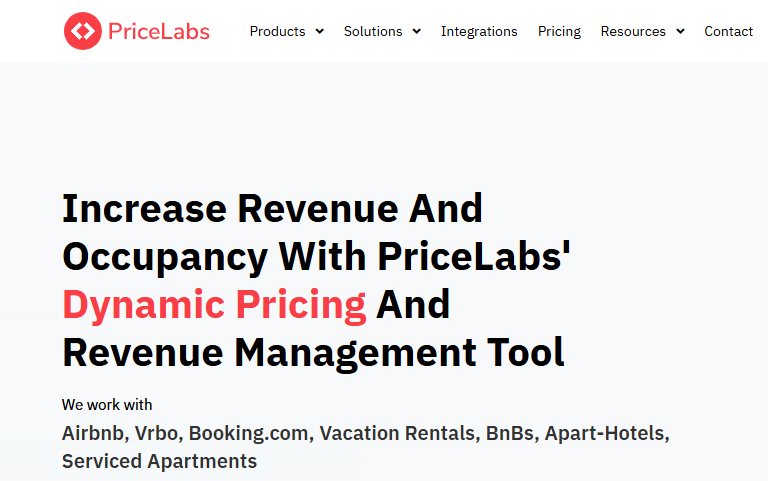How Airbnb’s Pricing Shift Is Reshaping How We Set Rates—and Understand Income Potential

A practical look at what total price transparency means for STR operators
This post contains affiliate links, which means I may earn a small commission if you choose to sign up — at no cost to you. I only partner with companies I personally use and believe will genuinely help you grow your short-term rental business.
🔍 TL;DR Summary
Airbnb’s global move to display the total price upfront—and shift the full service fee burden to hosts—isn’t just about guest transparency. It’s a fundamental change in how we think about nightly rates, how we compare to competitors, and how we estimate future income. In this post, we’ll explore:
What changed and why it matters
How this affects hosts’ ability to view competitor fee structures
Implications for tools like PriceLabs and AirDNA
How to rethink ADR in this new pricing environment
Airbnb’s Fee Shift
Tips for practically adjusting your pricing strategy
What this means for assessing income potential in new markets
What Changed: A Quick Recap
Due to a FTC ruling that went into effect May 2025 all OTA like Airbnb and VRBO had to change their pricing displays, and now standardized total price display is in effect - meaning that guests now see an all-in price (including cleaning, pet, and host fees) during search.
Additionally, for most new listings and increasingly across the platform, Airbnb is transitioning to a host-only fee model, where the 15% service fee is taken from the host payout instead of being split between host and guest.
This move was designed to simplify comparisons and build trust with guests, but for hosts, it raises a critical issue:
How do I set a price now that reflects my true value—without over- or under-shooting my market?

Loss of Fee Transparency: We Can Still Set Fees, But…
Previously, hosts could clearly see how much a competitor charged for cleaning or pet fees. Tools like PriceLabs even allowed us to filter by cleaning fee, helping parse out “base” nightly rate vs. total value.
That’s largely gone now—especially for Airbnb-only comps. Here's what's changed:
In-app fee breakdowns are phasing out or already gone for guests
PriceLabs and other pricing tools may lose access to fee-specific data for Airbnb
Competitor analysis becomes more complex, as we can no longer easily isolate base rate vs. one-time fees
You can still set a cleaning or pet fee within your Airbnb backend, but guests won't see it itemized until checkout. Most will focus on the total cost shown during search—and so should you.
So What is ADR Now, Really?
Let’s revisit something I’ve always taught:
ADR (Average Daily Rate) isn’t what you set—it’s what you receive.
You can set a base rate of $200/night, but if you add a $150 cleaning fee on a 2-night stay, your effective ADR is $275. That cleaning fee? Its revenue. Pet fee? Also revenue. HOA fee? Yep, also revenue. You may set those fees to directly correspond with an expense, but the reality is - that’s up to you. Its all revenue.
Now, with total price display and fewer visible fee structures there is less room to get hung up on fees - , you must think of your pricing holistically.
That means:
Total payout per stay ÷ nights booked = ADR
Look at guest stay patterns (e.g., lots of 2-night bookings with a cleaning fee? Your ADR is higher than your base)
Adjust your rate to reflect your true market value, not just to hit a psychological price point
What About Income Potential? How This Impacts Forecasting
This matters a lot if you’re:
Evaluating a potential purchase
Assessing whether your pricing strategy is competitive
Trying to understand how much you can reasonably earn from a property
Many hosts rely on AirDNA or similar platforms to get median ADRs or percentiles. But remember:
These platforms look at revenue divided by nights booked
They typically can’t parse out whether that revenue came from a high base rate or a strategic one-time fee
Now, with fee visibility disappearing, the assumptions behind the data are more opaque
→ The takeaway: Your comps may look similar on paper, but they may be pricing very differently in practice.
That makes your own pricing strategy even more important—and demands deeper local knowledge.
Rethinking Your Pricing Strategy in a “Total Price” World
Here’s how to adapt:
Back into your price from your target nightly payout:
Want $300/night? Consider your cleaning fee, Airbnb's 15% host fee, and taxes before setting the nightly rate.Use your direct booking site to offer strategic discounts or fees
You can still separate out cleaning/pet fees on your own site or even use “one-time fees” as conversion levers.Track real ADR and net income over time
Stop obsessing over the base rate and start tracking what you’re actually receiving, after platform fees and taxes.Leverage tools with multi-platform visibility
Tools like PriceLabs still help with pricing, especially when you sync across OTAs + direct. Use them alongside your own conversion and revenue data.
✅ACTION: Its time to spend some time evaluating your pricing. Don’t just look in your pricing tool or on platform only - assess it from various angles as if you are a guest booking. What is the total price at your comps? How about yours?
The Airbnb Fee Shift: Hosts Now Foot the Bill
Airbnb's move to consolidate the 15.5% service fee onto the host side (formerly split ~3% host / ~12% guest) changes more than just who pays — it changes how we calculate our nightly rate, estimate income potential, and understand what the guest sees.
🔍 What Changed?
Old Model: Guests paid a separate ~12% service fee; hosts paid 3%.
New Model (Total Price Display): Airbnb now shows a total price to guests, and deducts the entire 15.5% from the host payout.
Guests no longer see that the platform takes a cut — and hosts might not realize they need to adjust their pricing upward to avoid losing margin.
💡 What This Means for You
1. You Need to Back Into Your Desired Payout
If you want to earn $200/night, you can no longer set $200. You must now divide by (1 - 0.155) to account for the platform fee:
$200 ÷ 0.845 = $236.69
So you’d need to price at $236.69 just to net $200 after Airbnb’s cut.
2. Fee Transparency Is Gone — So Guests Will Just See Total Price
And this means:
You can still set a cleaning fee or one-time fee, but they’re no longer separated at checkout.
It’s harder to “hide” costs in fees without it impacting the perceived nightly rate.
As a result, pricing psychology becomes more important than ever.
3. You Still Have Strategic Control
This isn’t about price gouging — it’s about understanding what your true take-home is. For professional hosts, this becomes essential for:
Income modeling
Expense forecasting
Evaluating ROI on renovations or amenities
Add transparency to your listing: update your listing copy to note “Your total payment includes Airbnb’s Service Fee (15.5%), Damage Insurance, HOA fee, and as applicable Pet Fee”.

🙋♀️What Hosts Are Asking Me Now
Q: Should I roll my cleaning fee into my nightly rate?
It depends. For 2-night minimums, it often inflates total price—hurting your search appeal. But for longer stays, bundling can improve conversion.
Q: Will Airbnb’s pricing model reduce my bookings?
If you were relying on a low base rate + high cleaning fee to look cheap, possibly yes. But smart guests always compared total price anyway.
Q: How do I compare myself now to competitors?
You’ll need to search like a guest—plug in your target stay dates and see what total prices show. Look at properties in your area and scroll the map.
Final Thoughts: This Is a Shift in Mindset
Airbnb isn’t just changing the interface—it’s reshaping how guests perceive value. And as hosts, we must shift from:
❌ “How low can I price and still profit?”
✅ “How can I align my total value with what the right guest is willing to pay?”
The winners in this new model will be hosts who:
Understand their guest behavior
Have clarity on total per-night income
Adjust based on real payout data, not emotional pricing
Use tools and strategy to maintain control over profitability
***

I'm a big fan of tools that provide us the data needed to effectively manager our short-term rental. From insights to help us set our prices, to automations so we eek every possible dollar out. I'm not a fan of suggesting tech for tech's sake - if you only have (1) property, automate yourself first. Get familiar with what it means to monitor your market place and adjust your pricing, length of stay requirements, monitoring the booking lead time. Once you feel like you've got it down, then consider tools to help automate. I have used Pricelabs since I added a second property to my portfolio - that was a while ago. Do I wish I'd had it for the first one? Sometimes... I definitely left money on the table BUT that year was a helpful practice of understanding it. These tools are just that - tools. They make suggestions, and they automate. They do so based on averages - which may or may not be your property. Its worth the time to learn how to really use these tools - and understand the concepts behind them.
Check out some of my other posts about pricing and value:
Value, Pricing, and Marketing Your Short-Term Rental
Decoding the Power of Pricing in Short-Term Rentals
****
My business The CEO Host is all about helping STR owners and manger run their business like a Boss; around here, we leverage solid business principles, goals, and lifestyle focused investing to achieve our life's vision. We laugh at ourselves for taking on too much, reward ourselves for leveling up not just our lives - but our kids lives too, and live intentionally. If you are looking for some help to achieve this, lets CHAT and see how I can support you - be it getting more clarity, more organized and efficient, or just starting. My corporate experience, education, and logical, strategic approach to business has been a boon to short-term rental owners, operators, investors. I'm here to help those seeking to be in achieving goals faster with more confidence.
If you'd like to receive updates from The CEO Host, join our email list. No spam, just the occasional update to help your Short-term Rental business! Sign Up HERE
Find Me on FACEBOOK or Instagram or LinkedIn as @theceohost
*****

Hey Boss! I'm Kate, owner/founder of The CEO Host. If you are interested in taking a leap into short-term rentals - or have some questions about your existing business, my goal - passion, and career, is to help YOU succeed. I've coached hundreds of folks getting started or looking to optimize, analyzed more deals (and duds) than I could count, completed thousands of hours of education and training, attended conferences... So don't be shy. A good CEO knows to bring in expert help - and that's what I'm here for! Lets HOP ON A CALL and chat!
Take up the mantle of transparency
Categories: : STR finances taxes and risk management
 Kate Stoermer
Kate Stoermer 